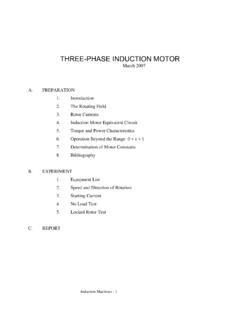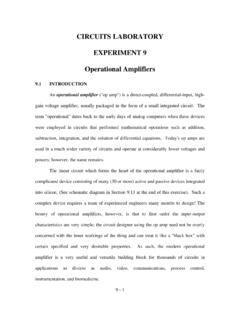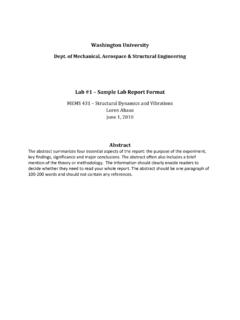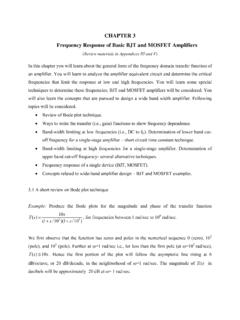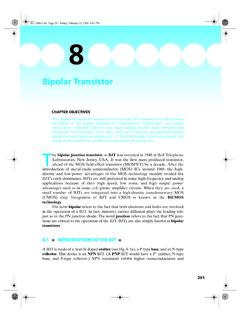Transcription of CIRCUITS LABORATORY EXPERIMENT 6
1 CIRCUITS LABORATORY EXPERIMENT 6 TRANSISTOR CHARACTERISTICS ABSTRACT In this EXPERIMENT , the output I-V characteristic curves, the small-signal low frequency equivalent circuit parameters, and the switching times are determined for one of the commonly used transistors: a bipolar junction transistor. INTRODUCTION The advent of the modern electronic and communication age began in late 1947 with the invention of the transistor.
2 Rarely has any component of any apparatus received the public attention and acclaim of this invention. Although everyone knows what a transistor radio is, few know how it works or why the transistor itself is so important in electronic systems. From an economic point-of-view its main advantages are small size, low-cost, and high reliability. Basically, however, the importance of the transistor derives from the fact that it is a three-terminal device that can provide amplification or gain.
3 The three terminals serve to isolate input and output, while gain allows for conversion of dc power into signal power. Two of the most important applications for the transistor are (1) as an amplifier in analog electronic systems, and (2) as a switch in digital systems. In this EXPERIMENT we will examine some of the characteristics of transistors in these modes of operation. For this purpose we will investigate one of the common transistors, the bipolar junction transistor (BJT). 6 - 1 BIPOLAR JUNCTION TRANSISTOR (BJT) Figure : Symbols for BJTs.
4 Basic Concepts The operation of the BJT is based on the principles of the pn junction. As indicated in Figure , there are two basic types: (a) the npn and (b) the pnp. In the npn, electrons are injected from the forward-biased emitter into the thin base region where, as minority carriers, they diffuse toward the reverse-biased collector. Some of these electrons recombine with holes in the base region, thus producing a small base current, iB. The remaining electrons reach the collector where they provide the main source of carriers for the collector current, iC.
5 Thus, if there are no electrons injected from the emitter, there will be (almost) no collector current and, therefore, the emitter current controls the collector current. Combining currents, the total emitter current is given as iE = iB + iC. ( ) Note that the total emitter current, iE = IE + ie, where IE is the DC component and ie is the time varying component. The behavior of the npn transistor is indicated schematically in Figure with the voltage polarities required for normal npn operation.
6 For normal pnp operation, the polarity of both voltage sources must be reversed. For the configuration 6 2 Figure : Representation of npn transistor in operation with forward biased emitter-base junction and reverse biased collector-base junction (e = electrons, 0 = holes, and oe = recombination of holes and electrons). shown in Figure , we can define a (normal operation) DC current gain as DC = IiC / IiE ( ) Since IC is somewhat less than IE , DC is a number less than one.
7 A typical value would be It is also useful to define a current transfer ratio as, DC = IC/IB ( ) Using Equations ( ) and ( ) in ( ), we get DC = DC/(1 - DC). ( ) If DC = , then DC = 99. When the BJT is used in a system with the emitter and base contacts as the input and the collector and base contacts as the output, from Eq. ( ) the current gain is less than 1. The forward-biased emitter-base junction, however, has a small impedance while the reverse-biased collector-base junction has a large impedance.
8 Thus, the voltage gain is large. This is called the common-base configuration. 6 3 .10mARVICCCC==When the BJT is used with the base and emitter terminals as the input and the collector and emitter terminals as the output, from Eq. ( ) the current gain as well as the voltage gain is large. It is for this reason that this common-emitter (CE) configuration is the most useful connection for the BJT in electronic systems. Figure 6. 3a: Cornmon-emitter Figure : Collector characteristic connections for npn transistor.
9 Curves for the common- emitter connection of npn transistor. This configuration is shown in Figure with the output I-V characteristics indicated in Figure Notice from the I-V characteristics that the output collector current is controlled by the input base current as modeled in Equation. ( ). Graphical Analysis A graphical analysis of the BJT as both a switch and an amplifier can be obtained from the output I-V characteristics by means of a load-line construction.
10 If we take Vcc = 10 volts and Rc = 1 k in Figure , then the load-line intercepts on the output characteristic are VCE = 10 volts and ( ) 6 - 4 VCE IBBase Current These points are indicated in Fig. The transistor output VCE and IC are now constrained by VCC and RC to have values only along the load-line indicated. Figure : Load-line construction and analysis. The operating point on the load-line, also called the Quiescent or Q point, is the BJT output set point.
